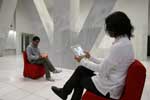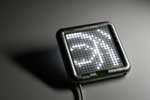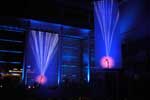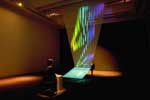When he took part for the first time in ArtFutura in 1994
(Reina Sofía Museum, Madrid), Toshio Iwai from Japan was
already one of the most important names on the international scene
of media art, and maybe his projects represent better than
those of any artist the new aesthetic horizon which was being
set in the dilemma between technology and visual expression. Ten
years later, time proves he was right.
At the age of 43, Iwai is already every inch a legend which is
still in force - his collabora-tions with Ryuchi Sakamoto
and his installations for the ICC or the ZKM are
classics of interactive art - having a decisive influence on the
work of the most important interaction designers and software
artists of the moment. From the great figures of digital art coming
up through John Maeda's reserve in the MIT to the
most daring videogame creators; they are all somehow heirs of
Iwai's legacy.
Iwai opened doors in the mid 90s when he was the first artist
to distribute one of his pro-jects through the industry of
videogames. In 2005 he repeats this experiment again with
Elektroplankton, a title for Nintendo DS which is equally
a musical game and a work of interactive sound art.
Iwai is still obsessed with the idea of relating sound and light
in playful and unforeseeable ways; so obsessed that his last project
is the creation of a new electronic musical instrument.
The Tenori-On is a sound panel of LEDs which is
manually programmed. The LEDs switch on at the same time as they
create sound. It is still a prototype, but Iwai hopes to be able
to produce and distribute it commercially, so that it can be enjoyed
by people who might not discover it if it were a museum piece,
and develop this kind of intimate and close relationship which
is difficult to establish with a standard work of art.
Text: José Luis de Vicente
Text originally published in ArtFutura's 2005 catalog.
|






